
views
Arranging Other Items around the Painting
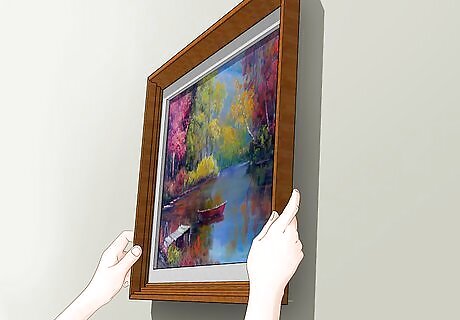
Hang the painting in an open area. Start by designating a spot along the wall for your painting where it will have at least 1–2 feet (0.30–0.61 m) of space in each direction. This will leave you with plenty of room to play around with when it comes time to bring in new decorations and accessories. It may be necessary to hang especially heavy pieces on a section of the wall where the supporting studs are located. Be sure to take this into consideration when envisioning a layout for the wall where you plan to show off your painting. Make sure the painting isn’t obscured by any furniture or architecture. If you have a large wall, use a large painting. A smaller painting will look odd and empty on a large wall.
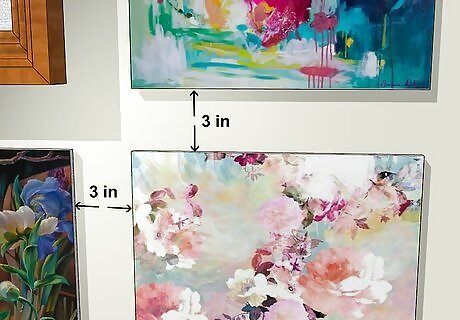
Fill the surrounding space with smaller pieces of art for symmetry. Place your decorative pieces around the sides and bottom of the painting at regular intervals to give the completed display a sense of symmetry. Try to leave about 2–3 inches (5.1–7.6 cm) between each frame—otherwise, your DIY gallery setup could easily end up looking too busy. Situate larger pieces towards the lower part of the wall to avoid taking attention away from your main painting. You might also consider mounting a greater number of secondary paintings and photos on the right-hand side of your main display piece. Since most people tend to read from left to right, their eyes will instinctively settle on the painting before anything else. A level can come in handy for double-checking that your artwork is hung correctly. Arrange everything on the floor and take a picture to use as a reference when you move it to the wall. Grids are very popular at the moment! You can try getting 12 to 16 different frames at the same exact shape to fill the space around your main piece.

Incorporate other miscellaneous decorative elements to personalize the wall. A gallery wall doesn’t have to be limited to paintings! Feel free to include framed photos, mounted sculptures, and ornamental objects like drawings or homespun needlepoints that hold sentimental value. If you’re creating your gallery wall with a variety of objects, be sure to stay within a color theme for the objects that also matches with the furniture in the space. A collage of family photos can lend a more personal touch to a collection of classical artwork. For a more creative display, you could even purchase custom-sized frames to showcase a few of your favorite movie posters, records, or other ephemera. If you have art that doesn’t look the same, put them in the same frame or use a similar frame color to make the pieces more cohesive.
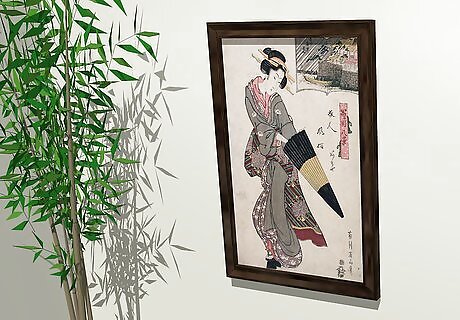
Arrange your furniture and accessories to correspond to the lines of the artwork. Minimalistic contemporary styles with a clean profile can make the perfect complement to pieces characterized by strong lines and angles. Similarly, colorful, wavy, or abstract art tends to pair well visually with elaborately curved objects like contoured vases and lamps. Houseplants and other accessories that mimic a few of the painting’s more prominent features can help create a three-dimensional effect that brings the artist’s work to life.

Use lighting elements to add visual emphasis. A simple underlight or ceiling-mounted spotlight can be enough to make a prized painting stand out in sharp relief to the rest of the room. If you don’t want to go to the trouble of installing special fixtures, try to configure your available light sources in such a way that they bathe the centerpiece in a soft glow. Just try to avoid harsh glares or forceful spotlighting. If you’re looking for a less conventional way to illuminate your gallery wall, experiment with warm, organic-looking sources like tea lights, Himalayan salt lamps, paper lanterns, or even candles. Finding the ideal lighting to your painting may require you to reposition it to a part of the wall that receives more exposure.
Drawing More Attention to the Painting

Make the painting the focal point of the room. Reserve a special spot for the piece right in the center of the longest wall, then appoint the rest of the room around it. It’s important that the painting be hung at eye level (when standing) to ensure that the viewer’s gaze falls on it effortlessly. When mounting artwork in the bedroom, the best place for it is either directly above the bed or on the opposite wall. If you decide to hang a painting above a fireplace, make sure there’s some kind of barrier in place just below it, such as a mantle or molded ledge, to protect it from the rising heat. Put a spotlight or frame the art in wall moldings if it’s a focal point of the room.
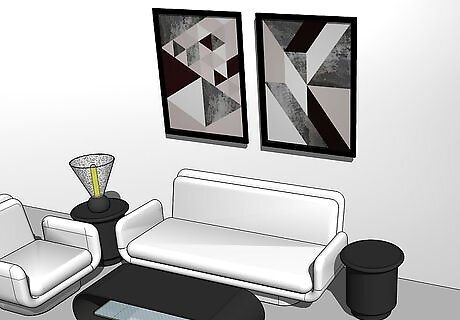
Pull the colors of the painting out into the rest of the room. Pick out secondary furnishings and accessories like curtains, rugs, lampshades, and throw pillows in color schemes that echo the hues featured in your artwork. Establishing continuity between like colors will make the painting feel like a natural extension of the room, and vice-versa. Black-and-white portraits, for instance, can be even more striking when juxtaposed with a muted or monochromatic palette and modest patterns and textures. Similarly, pieces boasting splashes of vibrant color lend themselves well to pairing with furniture and accessories in daring color choices (so long as they don’t clash).
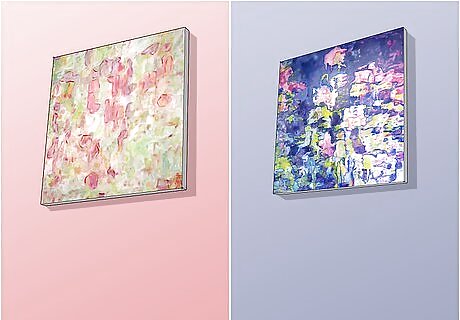
Paint the walls in one of the painting’s primary colors. Single out one of the most pervasive colors in your main display piece and use it as the base shade for the rest of the room. A natural landscape, for example, might look right at home when nestled into a sea of night sky blue, hay gold, or hunter green. Generally speaking, it’s a good idea to stick to more neutral colors that won’t look tacky or be overwhelming to the eyes. This means that that hot pink or bright yellow found in one or two bold brushstrokes may not make the best choice for your entire living room. Use a bright and colorful painting if you want it to stand out from the wall. Use an online room designer program to virtually recolor the walls of your home or office and see what you think of the change.

Space the painting an equal distance between windows. If there’s more than one window in the wall where you want to hang your painting, it can make centering a little trickier. The simplest solution is to use a tape measure to find the distance between the two central windows, then subtract the width of the painting itself. Divide that number in half to determine how much room you should leave on either side. Don’t forget to account for the dimensions of the frame when you’re doing your measuring. Avoid sticking eye-catching pieces where they might be partially covered by curtains or open shutters. Avoid squeezing a painting into a tight space.
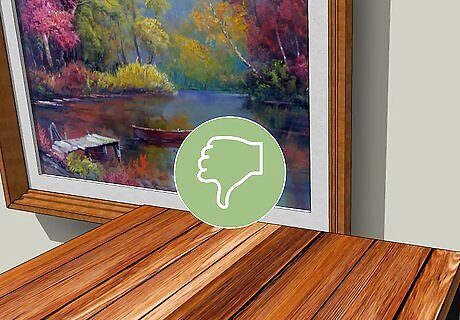
Keep the area free of anything that might distract from the painting. Take care not to obscure your artwork with irregularly-shaped furniture (such as a high-backed chair or sofa) or decorations with protruding components. By the same token, anything that moves, lights up, or features loud colors or slogans could prove to be an unwanted attention-grabber, and should be given a home in a different area. Minimize potential distractions by moving them outside of your field of vision when looking at the painting head-on. If they’re still noticeable, consider relocating them to a different part of your home or office altogether. Turn, tilt, cover, or push back any nearby items that are too big to move to make them less conspicuous. Your art should be the main attraction of the room it’s displayed in (or at least the walls).



















Comments
0 comment